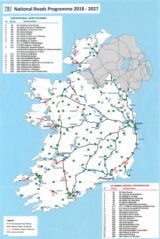In terms of regional and interregional mobility within Ireland, surface mode transport – both road and rail networks are important and will become more so. We are a growing country. Project Ireland 2040 projected an extra million people by 2040. We have already experienced population growth of 8 per cent in the intercensal period 2016-2022, with some counties in the Western Region experiencing higher growth rates. A summary report of Census 2022 data on the Western Region is available here. The ESRI is currently engaged by the Department of Housing, Local Government and Heritage to review the projections with the Census 2022 data that is now available.
To support this population growth we need to invest in our infrastructure. The WDC welcomes the publication of the Draft All Island Strategic Rail Review (AISSR). We must also ensure continued delivery of the planned improvements to the road network, many of which have been committed to for a long time.
This blogpost discusses transport accessibility in the Western Region and reviews some of the projects for the Region outlined in the Draft AISSR. I also review some of the key roads projects that remain outstanding and are important to transport accessibility and development of the Region and the wider delivery of Project Ireland 2040.
Multi-modal Transport Accessibility
Investment in transport is often considered on a mode specific basis; for example ‘the roads budget’ or rail investment reviews such as the Draft AISSR. In doing so, the combined effect on overall transport accessibility to a specific region or on a specific route is missed or often not considered. The poor transport accessibility to the North-West – with much of the region devoid of rail infrastructure and at the same time awaiting the delivery of several important road investment projects is one example.
Poor accessibility in one region is compounded by improvements in transport infrastructure elsewhere. So as investment in road and rail links continue apace elsewhere with improved journey times, the relative perception of poor transport accessibility in some regions can remain even despite actual incremental improvements.
Examining investment in surface mode transport infrastructure, the most significant expenditure has been on road transport. Especially since the 1980s there has been a steady stream of roads investments, initially supported by EU structural funds and then through the Exchequer and various National Development Plans. In contrast while there has been some investment in the rail network it has only been in more recent decades that there has been actual expansion in the network and services.
National Road Network
Last year, (May 2022) Transport Infrastructure Ireland (TII) published its annual National Roads Indicators Report, see here. There is a wealth of information included, and some that is particularly useful in the context of regional development and transport accessibility. The TII maps show the impact of investment in the national road network, on employment accessibility at different points in time, see here. TII has plotted accessibility to jobs for a number of key milestones in the development of the National Roads Network. There is a detailed discussion on the methodology used by TII available here).

In 2006, prior to the completion of the Major Inter Urban (MIU) corridors linking the capital to the other cities; accessibility to jobs was weak (orange, beige and red), all along the Western seaboard and extending east to the Midlands. The dark green depicts high accessibility which in 2006 extended across Dublin and into the Greater Dublin Area.
By 2010 the development of the MIUs delivered significant improvements in terms of accessibility to jobs extending beyond the Greater Dublin Area and into the Midlands. The impact of the opening of the M6 (Galway-Dublin) is evident in the change between 2006 and 2010 and improved accessibility along that route.

Since 2016, there are only subtle changes in accessibility (e.g. along the M17/M18 corridor), related to the reduced capital spend on National Roads infrastructure during that time.
The 2021 map shows the effects of the M17/M18, M11 Gorey to Enniscorthy and N25 New Ross Bypass projects which were completed since 2016. These projects have enhanced accessibility in the West and South-East of the country. It is also relevant that these roads projects were less about improving links to the capital and more about improving intra (within) and inter (between) regions. Nonetheless, as the TII report concludes..Despite the above, peripheral areas in North-West, West and South-west and South-East still tend to suffer from poor accessibility to jobs (p.31).
It is very clear from the maps above that investment in the road network – especially where it has been poor – can have very positive impacts. It is also clear that many parts of the West and North west (in addition to coastal fringes) suffer relatively poor accessibility.
Planned Roads Investment
While connectivity to Dublin from most regions has improved considerably in the last decade, inter-regional connectivity is in parts quite poor. The WDC considers that to make the best use of existing infrastructure it would be important to fully capitalise on state investments already undertaken: Improving existing networks and completing ‘unfinished sections’ should be a priority. For example as the Gort-Tuam M17/M18 motorway is complete, the priority should be to improve the outstanding sections on the N17 north of Tuam to Sligo.
National primary and secondary routes are critical for inter-regional linkages and ensuring access from more rural areas to services and employment in larger urban centres. As the current NDP notes, the other major objective is to make substantial progress in linking our regions and urban areas not just to Dublin but to each other. This will be a major enabler for balanced regional development to occur. A particular priority in this is substantially delivering the Atlantic Corridor, with a high quality road network linking Cork, Limerick, Galway and Sligo. The programme of investment set out in the National Development Plan, and as illustrated by figure 5.2, aims to achieve these objectives. [TII map below]See here.
There are roads projects committed to and in planning that will significantly improve the relatively low accessibility. Many have been proposed and included in various previous National Development Plans, some of which were first listed in National Development Plans dating back to 2000, (e.g. NDP 2000-2006, p.12, 13). The National Development Plan 2018—2027 see here restates some of these projects which include the roads projects below. Their status as outlined by Transport Infrastructure Ireland in March 2023 see here, is in italics.
- N17 Knock to Collooney: Construction timeline Post 2026
- N4 Mullingar to Longford upgrade: Construction timeline Post 2026
- N4 Carrick-on-Shannon to Dromod: Construction timeline Post 2026
- N14/15/A5 Link (approved in 2012 waiting on A5 development): To be confirmed
- N5 Ballaghaderreen to Scramoge Road. Construction timeline Q1 2023
Delivering on identified and agreed road projects should be a priority. Especially as most are not ‘new’ projects but have been identified many years earlier and restated many times.

The National Rail Network
The Draft All Island Strategic Rail Review (AISRR) published on 25 July 2023 was commissioned jointly by the Department of Transport and the Department for Infrastructure in Northern Ireland.
It is a Draft report, containing 30 recommendations for delivery over the short-term (to 2030), medium (2030 and 2040), and long-term (2040 and 2050), see appendix 1 below for full list of 30 recommendations. However the report makes clear that these recommendations ‘do not represent official policy’ but ‘plausible choices’ for policy makers to consider for further analysis. The report notes that more detailed work will be needed to test the feasibility and affordability of many of the recommendations to inform decision making. The capital cost is estimated to be €36.8bn/£30.7bn in 2023 prices, approximately 75% of which applies to Ireland.
As the AISSR notes the island’s rail network reached its peak around 1920, with over 5,500km – one of the densest railway networks in the world. However, between the 1930s and the 1970s the network shrank substantially. These closures occurred in part due to the historical pattern of consumer behaviour with a preference for the car as well as relatively poor transport options. The AISSR also notes the impact of partition which introduced customs between Northern Ireland and the Republic which impacted heavily on cross border rail.
Since the 1990s, there has been some growth in the railway network, for example the launch of the DART network in 1984 and investment in the Belfast-Dublin Enterprise service in the 1990s. In the 1990s passenger services were reinstated between Limerick and Ennis, and these were extended to Athenry in 2010.
In the context of transport accessibility it is welcome that the AISSR recognises that rail is just one part of the transport network and to work successfully it needs to be well connected to the road network enabling bus services. As part of an integrated transport solution, the rail system could evolve to be a stronger ‘backbone’ of the public transport system, providing a core network of connectivity between urban areas and regions (p.26)….. Heavy rail is less suited to supporting lower demand corridors and more isolated communities but it can complement regional bus service that could connect these communities to the wider public transport system (p27).
The Review followed a Public Consultation in 2021/21 and considered a wide range of proposals over the period to 2050 ranging from projects requiring significant capital spend such as new railways to smaller scale operational improvements requiring less investment for example increased frequencies.
Understandably with any large scale investment, much will be over the longer-term with some planned deliverables in the short and medium term. Many of the works requiring significant capital investment will be subject to further analysis and evaluations complying with the Government Spending Code and Capital Appraisal Framework.
The final recommended list of proposals contains approximately half of the over 70 geographic specific projects examined.
Rail projects serving the Western Region that are in the final set of recommendations include:
- Increased no of services: one train per hour (Intercity Dublin -Galway).
- Increased no of services: one train per two hours Dublin-Sligo, Dublin – Westport/Ballina, Galway-Limerick).
- Double-tracking Galway-Athenry.
- Re-instatement single-track Claremorris-Tuam-Athenry.
- Increased speeds (Intercity Galway-Dublin top speed 200km/h)
- Increased speeds other regional routes increased speeds (Dublin- Sligo/ Westport/Ballina/ Galway-Limerick – top speed 120km/h)
The maps below outline today’s railway (A) network showing the single, double and four track sections along with the electric sections and (currently) planned upgrades (AISSR, p.22.Figure 1). The map showing a potential future railway (B) (AISSR pg 12), outlines electrified and new railways, track upgrades and other improvements.

Service Frequencies
Additional capacity will be needed on parts of the network to deliver extra frequencies. This will involve dual tracking and some four-tracks especially in the approaches to Dublin. Double tracking between Galway and Athenry is also proposed. Frequency improvements on lines serving the Western Region include; one train per hour (Intercity Dublin -Galway) and one train per two hours Dublin-Sligo, Dublin – Westport/Ballina, Galway-Limerick.
Journey Times
In the context of growing passenger numbers, the Review argues that journey times between the main cities should be materially faster than car journeys (p.45). To allow for stops and waiting times this suggests an operating speed to 200km/h which is provided for from the 5 cities (Galway, Limerick, Cork, Waterford, Belfast) to Dublin. For routes from Sligo and Mayo the line speeds will not be as fast but will be increased (to speeds of up to 120km/h) so as to more effectively compete with car journey times (AISSR p. 77). To improve journey times investment in signalling, track condition, level crossings and rolling stock will be needed.
New Lines
Apart from double-tracking between Galway and Athenry the only significant investment in the Western Region is the proposed re-instatement of the single-track Claremorris-Tuam-Athenry.
In undertaking a review of Colloney – Claremorris, the Review noted that there would be very low demand for passenger rail services on this route and that building a railway on this corridor would have a significant adverse impact on the environment.
For the Claremorris-Athenry section the assessment was that the line is an important link for the island’s rail freight network, and that the town of Tuam would probably generate demand for a passenger service.
Elsewhere it suggests that the line could be reopened for freight in the first instance which may indicate lower journey speeds. Given the earlier discussion on the importance of rail journey times being competitive with the car, higher line speeds especially on the Tuam-Athenry section may be justified. If the line is to open passenger services it would be important to ensure the service compared well with road. Notwithstanding the congested road network, most journeys south from Tuam will be destined for Galway city, requiring a change at Athenry. Good journey times from Tuam to Athenry will be necessary to ensure take-up.
Conclusion
Transport infrastructure, especially roads and rail projects can take a long time to plan and deliver.
When projects have been identified, agreed and restated in many Government plans and investment programmes, there should be an urgency to deliver. Surface transport investment for both passengers and freight should not be considered in isolation but should be seen as complementary and investment should ensure linkages between modes. Census 2022 has shown that our population has grown by 8% over the last six years. Population and employment growth is projected to continue with an extra 1 million people by 2040. The Government’s plan to cater for that growth – Project Ireland 2040 highlights various investments needed to support this growth in a sustainable and balanced way. Commitments within it should be delivered at the earliest opportunity.
Deirdre Frost
Policy Analyst
The views expressed here are those of the author and do not necessarily represent or reflect the views of the WDC.
Appendix 1 Draft All Island Strategic Rail Review (AISRR)
The Final Package of Recommendations
In summary, the key interventions included identified as recommendations for this Review are:
Short Term and Decarbonisation:
- Electrification of intercity and commuter services between Belfast-Bangor, Belfast- Drogheda, Dublin-Cork, Portarlington-Galway, Limerick Junction-Limerick, and Kildare-Waterford.
- Speed upgrades to 160km/h (100mph) on core and some regional intercity lines.
- One train per hour on intercity routes between Dublin and Belfast, Cork, Limerick, Galway, and Waterford.
- One train per two hours on regional routes including Galway-Limerick, Limerick-Cork, Limerick-Ballybrophy, Dublin-Sligo, Dublin-Westport/Ballina, and Greystones-Rosslare Europort.
- Through services between Cork and Galway via Limerick with modifications to track and platforms at Limerick Junction to allow more through movements Cork-Limerick.
- Direct services between Belfast and Portrush.
- New passenger services to the Limerick-Foynes line and a spur to Shannon Airport.
- Reinstatement of the Lisburn-Antrim line with a station at Belfast International Airport.
Intercity:
- A new 200km/h (125mph) line from Belfast to Newry via Hillsborough, Dromore, and Banbridge, with connections to the Lisburn- Antrim line and towards Portadown.
- A new 200km/h (125mph) line linking Drogheda to Clongriffin with four-tracking from Clongriffin to Connolly/Spencer Dock.
- A spur to Dublin Airport from Clongriffin.
- A cross-Dublin tunnel from the north of Spencer Dock to Heuston, with connections for DART and MetroLink at several stations in Dublin City Centre.
- A short link between Maynooth and Adamstown to separate longer-distance trains from the DART services.
- A new 200km/h (125mph) double-tracked electrified alignment between Hazelhatch and Portarlington and a link to the Kildare- Waterford line.
- Double tracking from Dublin as far as Mullingar, Athlone, and Kilkenny, as well as between Galway and Athenry.
Regional and Rural Packages:
- A new 160km/h (100mph) dual-tracked electrified line between Portadown and Derry-Londonderry.
- A new single-track line between Derry-Londonderry and Letterkenny.
- New stations between Derry-Londonderry and Coleraine, including a spur to Limavady.
- Dual-tracking and new stations between Belfast and Antrim (on the existing Belfast – Derry-Londonderry line).
- A new single-track line between Portadown and Mullingar via Armagh, Monaghan, Clones, and Cavan.
- A reinstated single-track line between Mullingar and Athlone.
- A reinstated single-track line between Claremorris and Athenry via Tuam.
- A reinstated single-track line between Waterford and south of Wexford.
- A curve at Limerick Junction to facilitate through services between Cork-Waterford.
- Enhancements to capacity and alignment along the Limerick Junction-Waterford line.
- Other interventions including enhanced port connectivity, inland freight terminals, reduced freight access charges, and customer experience initiatives were not quantitively assessed but have been qualitatively assessed and are included in the Review’s recommendations.
Decarbonisation recommendations
- Develop and implement an All-Island Rail Decarbonisation Strategy that includes an electrified intercity network.
- Develop plans to invest in the skills, supply chains, and rolling stock to deliver decarbonisation.
- Procure hybrid and electric rolling stock in the medium term.
Intercity recommendations
- Upgrade the cross-country rail network to a dual-track railway (and four-track in places) and increase service frequencies.
- Upgrade the core intercity railway network to top speeds of 200km/h (125mph).
- Develop short sections of new railways on congested corridors.
- Develop a cross-Dublin solution.
Regional and rural recommendations
- Provide more direct services between Ireland’s est and outh oasts.
- Ensure regional and rural lines have at least one train per two hours.
- Increase line speeds to at least 120km/h (75mph).
- Upgrade Limerick Junction and the Limerick Junction – Waterford line.
- Reinstate the Western Rail Corridor railway between Claremorris and Athenry.
- Extend the railway into Tyrone, Derry~Londonderry, and Donegal.
- Reinstate the South Wexford Railway.
- Develop the railway to boost connectivity in the North Midlands.
- Integrate bus service and rail service timetables to connect communities where direct rail access proves to be unviable.
Sustainable cities recommendations
- Connect Dublin, Belfast International, and Shannon Airport to the railway and improve existing rail-airport connections.
- Extend double tracking in the Belfast area.
- Segregate long-distance/fast services from stopping services.
- Explore the case for developing new stations in the Belfast, Cork, Derry~Londonderry (including a spur for Limavady), and Limerick – Shannon city regions.
Freight recommendations
- Develop a sustainable solution for first-milelast- mile rail access for Dublin Port.
- Reduce Track Access Charges for freight services.
- Strengthen rail connectivity to the island’s busiest ports.
- Develop a network of inland terminals close to major cities on the rail network.
Customer experience recommendations
- Continue to invest in initiatives that deliver a seamless customer journey.
- Continue to benchmark and monitor service quality and deliver continuous improvement.
- Ensure future rolling stock specifications are aligned to the infrastructure-led interventions outlined in this Review.
- Invest in improving integration within rail and between rail and other transport options.
- Deliver ‘clock-face’ timetable calling patterns.
- Develop cross-border structures to improve the effectiveness of cross-border infrastructure and rail service planning.




